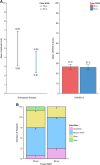Pulse duration settings in subthalamic stimulation for Parkinson's disease
- PMID: 29165837
- PMCID: PMC5813170
- DOI: 10.1002/mds.27238
Pulse duration settings in subthalamic stimulation for Parkinson's disease
Abstract
Background: Stimulation parameters in deep brain stimulation (DBS) of the subthalamic nucleus for Parkinson's disease (PD) are rarely tested in double-blind conditions. Evidence-based recommendations on optimal stimulator settings are needed. Results from the CUSTOM-DBS study are reported, comparing 2 pulse durations.
Methods: A total of 15 patients were programmed using a pulse width of 30 µs (test) or 60 µs (control). Efficacy and side-effect thresholds and unified PD rating scale (UPDRS) III were measured in meds-off (primary outcome). The therapeutic window was the difference between patients' efficacy and side effect thresholds.
Results: The therapeutic window was significantly larger at 30 µs than 60 µs (P = ·0009) and the efficacy (UPDRS III score) was noninferior (P = .00008).
Interpretation: Subthalamic neurostimulation at 30 µs versus 60 µs pulse width is equally effective on PD motor signs, is more energy efficient, and has less likelihood of stimulation-related side effects. © 2017 The Authors. Movement Disorders published by Wiley Periodicals, Inc. on behalf of International Parkinson and Movement Disorder Society.
Keywords: Deep brain stimulation; Parkinson's disease; pulse width; stimulation parameters; subthalamic.
© 2017 The Authors. Movement Disorders published by Wiley Periodicals, Inc. on behalf of International Parkinson and Movement Disorder Society.
Figures


Comment in
-
Next generation programming.Mov Disord. 2018 Feb;33(2):186. doi: 10.1002/mds.27322. Epub 2018 Jan 25. Mov Disord. 2018. PMID: 29369418 No abstract available.
References
-
- Volkmann J, Moro E, Pahwa R. Basic algorithms for the programming of deep brain stimulation in Parkinson's disease. Mov Disord 2006;21(suppl. 14):S284‐S289. - PubMed
-
- Volkmann J, Herzog J, Kopper F, Deuschl G. Introduction to the programming of deep brain stimulators. Mov Disord 2002;17(suppl. 3):S181‐S187. - PubMed
-
- Schrag A, Sampaio C, Counsell N, Poewe W. Minimal clinically important change on the Unified Parkinson's Disease Rating Scale. Mov Disord 2006;21(8):1200‐1207. - PubMed
-
- Ranck J. Which elements are excited in electrical stimulation of mammalian central nervous system? Brain Res 1975;98:417‐440. - PubMed
Publication types
MeSH terms
LinkOut - more resources
Full Text Sources
Other Literature Sources
Medical

